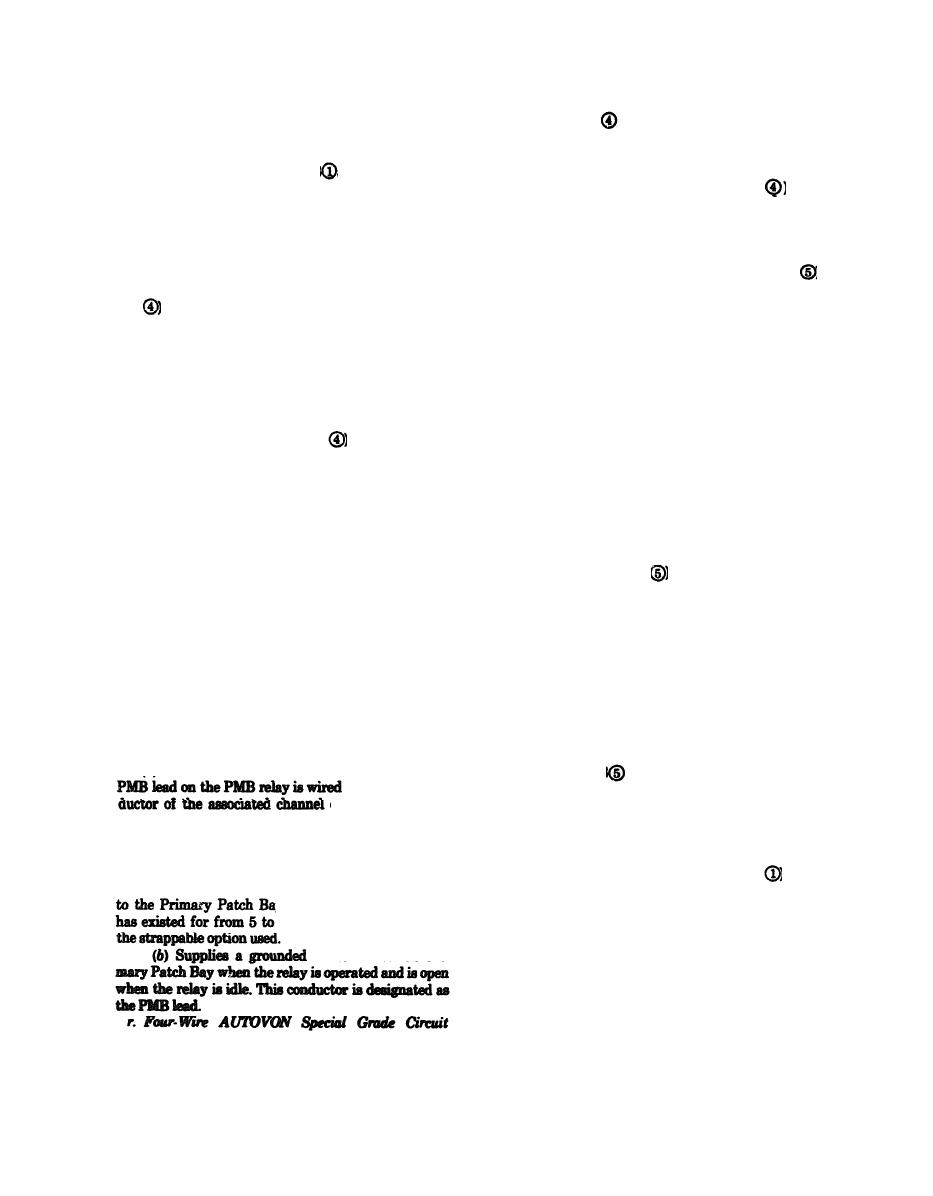 |
|||
|
|
|||
|
Page Title:
Four-Wire Voice Frequency Carrier Telegraph |
|
||
| ||||||||||
|
|
 TM 11-5895-1012-10
mary Patch Bay and does not access the Equal Level
(AUTOVON Subscribers (Data) and Inter-Switch
Trunks) (Fig. 2-8 ). This circuit operates the same
Patch Bay as the circuit involved does not go off base.
as that described in q above except that delay equaliza-
A two-wire/four-wire terminating set shall be required
tion devices are provided for data use.
at the PBX location. Normally the E&M leads will be
s. Four-Wire AUTOVON Voice Grade Circuit (Re-
extended as shown in figure 2-8 and described in e
mote AUTOVON Four-Wire User) (fig. 2-8
). This
above. Where the loop resistance exceeds 50 OHMS, sig-
circuit operates the same as that described in q above
nal extension units (DX) shall be required at the PBX
location and at the Technical Control Facility. Split
except that the circuit connects to remote AUTOVON
controlled echo suppressors, pads and amplifiers when
four-wire users.
t. Voice and Telegraph Users Connected to High
required are inserted into the circuit as shown.
Frequency Radio Transmission Media (fig. 2-8
p. Four-Wire AUTOVON Subscriber Telephone Ca-
Voice and telegraph using high frequency radio trans-
ble to TCF (Loop Resistance Less Than 700 Ohms) (fig.
mission for long distance communications accesses the
2-8 ). This AUTOVON telephone is located less
Primary Patch Bay of the Technical Control Facility as
than 700 ohms from the collocated TCF and AUTO-
VON switch. In this case the circuit accesses the Pri-
audio or dc circuits. The circuits shown illustrate the
mary Patch Bay, connects to repeat coils and level ad-
setup for high frequency independent sideband trans-
mission made up of four 3-kHz bandwidth channels.
justment equipment, and returns to the Primary Patch
The typical four channel system depicted is equipped
Bay with E&M lead appearance and then proceeds to
for three voice channels (A2, B1, B2) and one VF tone
the collocated AUTOVON switch.
package consisting of 16 date channels (Al). Line con-
q. Four-Wire AUTOVON Circuit (Remoter Two-
Wire PBX Subscribers) (Fig. 2-8
. This trunk cir-
ditioning equipment for these circuits before they ac-
cess the Equal Level Patch Bay includes: a telephone
cuit originates at the AUTOVON switch collocated
with the Technical Control Facility. The circuit inter-
terminal set or channel for each of the three voice cir-
connects at the Equal Level Patch Bay to transmission
media for service to remote two-wire PBX AUTOVON
for the dc circuits. Separate pads and/or amplifiers are
subscribers. provision is made for an echo suppressor
provided for the VF tone package before it accesses the
when the PBX is two-wire. This circuit appears on the
Equal Level Patch Bay.
Equal Level Patch Bay and pads and amplifiers are
u. Four-Wire Voice Frequency Carrier Telegraph
provided for level adjustment. As this circuit is desig-
(VFCT) Packages (fig. 2-8 ). This circuit consists of
nated to interconnect with multiplex facilities, a pilot-
multiple teletypewriter signals which enter the Tech-
make-busy (PMB) circuit is used as follows:
nical Control Facility at the Primary and Dc Patch
(1) The Group Pilot Control (GPC) alarm circuit
Bays and are then combined into a "tone package" at a
furnishes output leads (one for each channel in the as-
voice frequency carrier telegraph (VFCT). The VF tone
sociated group) which are grounded when group fail-
package employs a nominal 4-kHz channel bandwidth
ure occurs. The GPC alarm indicates normal operation
and appears at the Equal Level Patch Bay as an audio
with an "open" circuit condition.
signal. Although VF level control can, in most cases,
(2) On each channel associated with group using
be achieved by the VFCT equipment, pads and ampli-
the GPC alarm function, the GPC alarm leads are ex-
fier may be installed in the circuit prior to accessing
tended to the sleeve conductor of the associated Equal
the Equal Level Patch Bay, if necessary.
Level Patch Bay channel line jack.
v. Fixed Station Voice Frequency Multiplex Inter-
(3) On each AUTOVON trunk circuit the input
connection (fig. 2-8 ). This is the normal configura-
to the sleeve con-
tion of a frequency circuit between the Equal
on the Equal Level
Level Patch Bay and the fixed station multiplex equip
Patch Bay equipment jack. The coil of the PMB relay
ment. The only interface requirements are level con-
has sufficient voltage connected to it to operate the re-
trol and the PMB circuit which is described in q above.
lay when ground is applied to the GPC output lead.
w. Non-DCS Multiplex Users to DCS User On-Base
(4) The PMB relay operates as follows:
or Using DCS Transmission Media (fig. 2-8 ). This
(a) Open the E lead connection from the SF unit
circuit is provided to interface a tactical multiplex us-
y after the alarm condition
ing a non-standard method of telephone signalling to
50 seconds depending upon
user circuits conditioned for the standard signalling
interface at the Equal Level Patch Bay. After an ap-
conductor to the Pri-
pearance at the Primary Patch Bay, a signal converter
compatible with the signal used by this multiplex is in-
stalled to change the nonstandard tone signal to E&M
type of supervision. These dc signals are converted to
single frequency tones by a signal frequency unit; a
2-22
|
|
Privacy Statement - Press Release - Copyright Information. - Contact Us |